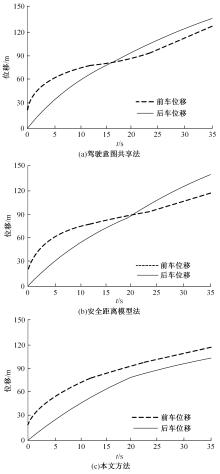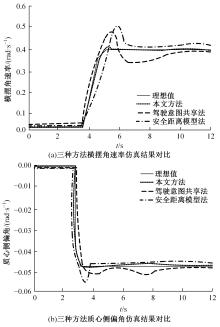吉林大学学报(工学版) ›› 2023, Vol. 53 ›› Issue (8): 2404-2409.doi: 10.13229/j.cnki.jdxbgxb.20220377
• 通信与控制工程 • 上一篇
基于单亲遗传算法的无人驾驶汽车主动避撞方法
- 辽宁工业大学 汽车与交通工程学院,辽宁 锦州 121001
Active collision avoidance method of driverless vehicle based on partheno genetic algorithm
- School of Automobile and Traffic Engineering,Liaoning University of Technology,Jinzhou 121001,China
摘要:
为有效提升无人驾驶汽车的主动安全性,提出基于单亲遗传算法的无人驾驶汽车主动避撞方法。利用归一化处理方位角评估函数构建无人驾驶汽车动力学模型。根据行为轨迹预测结果提前采取预制动,并以初始点至终点路径最短为目标,引入单点基因复制策略实施遗传操作,获取无人驾驶汽车主动避撞最优解。仿真结果表明:该方法可在紧急工况下规划出可靠的转向避撞路径,车辆状态参数平稳,路径偏差小,对不同车速及转向路径均具备较强鲁棒性。
中图分类号:
- U461.2
| 1 | 黄晓明, 蒋永茂, 郑彬双, 等. 基于路表摩擦特性的无人驾驶车辆安全制动原理与方法[J]. 科学通报, 2020, 65(30): 3328-3341. |
| Huang Xiao-ming, Jiang Yong-mao, Zheng Bin-shuang, et al. Theory and methodology on safety braking of autonomous vehicles based on the friction characteristic of road surface[J]. Chinese Science Bulletin, 2020,65(30): 3328-3341. | |
| 2 | 张立铭. 大数据支持下考虑障碍避让的机器人路径规划[J]. 计算机仿真, 2021,38(1): 312-315. |
| Zhang Li-ming. Robot path planning considering obstacles avoidance supported by big data[J]. Computer Simulation, 2021, 38(1): 312-315. | |
| 3 | Bachmann M, Morold M, David K. On the required movement recognition accuracy in cooperative VRU collision avoidance systems[J]. IEEE Transactions on Intelligent Transportation Systems, 2020(99): 1-10. |
| 4 | 王江锋, 刘雨桐, 王梦玉, 等. 车车通信环境下基于驾驶意图共享的车辆避撞预警算法[J]. 中国公路学报, 2020, 33(6): 65-76. |
| Wang Jiang-feng, Liu Yu-tong, Wang Meng-yu, et al. Warning algorithm of vehicle collision avoidance based on driving intention sharing in vehicle-to-vehicle environment[J]. China Journal of Highway and Transport, 2020, 33(6): 65-76. | |
| 5 | 赵林峰, 张丁之, 王慧然, 等. 基于改进安全距离模型的人机协同纵向避撞研究[J]. 汽车工程, 2021, 43(4): 588-600. |
| Zhao Lin-feng, Zhang Ding-zhi, Wang Hui-ran, et al. Study on longitudinal collision avoidance with human machine cooperation based on improved safety distance model[J]. Automotive Engineering, 2021, 43(4): 588-600. | |
| 6 | Liu J, Ji J, Ren Y, et al. Path planning for vehicle active collision avoidance based on virtual flow field[J]. International Journal of Automotive Technology, 2021, 22(6): 1557-1567. |
| 7 | 周兵, 万希, 吴晓建, 等. 紧急避撞工况下的路径规划与跟踪[J]. 湖南大学学报: 自然科学版, 2020,47(10): 10-18. |
| Zhou Bing, Wan Xi, Wu Xiao-jian, et al. Path planning and tracking in scenario of emergency collision avoidance[J]. Journal of Hunan University (Natural Sciences), 2020, 47(10): 10-18. | |
| 8 | Tak S, Yoon J, Woo S, et al. Sectional information-based collision warning system using roadside unit aggregated connected-vehicle information for a cooperative intelligent transport system[J]. Journal of Advanced Transportation, 2020(5): 1-12. |
| 9 | 李金城, 丁军君, 李芾, 等. 高速道岔车辆动力学指标研究与过岔计算[J]. 铁道标准设计, 2020, 64(10): 157-162. |
| Li Jin-cheng, Ding Jun-jun, Li Fu, et al. High-speed turnout vehicle dynamics index research and vehicle dynamics calculation[J]. Railway Standard Design, 2020, 64(10): 157-162. | |
| 10 | Brik B, Ksentini A. Toward optimal MEC resource dimensioning for a vehicle collision avoidance system: a deep learning approach[J]. IEEE Network, 2021, 35(3): 74-80. |
| 11 | 唐兆, 董少迪, 罗仁, 等. 人工智能算法在铁道车辆动力学仿真中的应用进展[J]. 交通运输工程学报, 2021, 21(1): 250-266. |
| Tang Zhao, Dong Shao-di, Luo Ren, et al. Application advances of artificial intelligence algorithms in dynamics simulation of railway vehicle[J]. Journal of Traffic and Transportation Engineering, 2021, 21(1): 250-266. | |
| 12 | Wang H, Fu Z, Zhou J, et al. Cooperative collision avoidance for unmanned surface vehicles based on improved genetic algorithm[J]. Ocean Engineering, 2021, 222(15): 1-25. |
| 13 | 唐敏, 王东强, 曾鑫钰. 汽车碰撞预警主动安全预测方法[J]. 计算机科学, 2020, 47(4): 318-322. |
| Tang Min, Wang Dong-qiang, Zeng Xin-yu. Active safety prediction method for automobile collision warning[J]. Computer Science, 2020, 47(4): 318-322. | |
| 14 | 彭浩楠, 唐明环, 查奇文, 等. 自动驾驶汽车双车道换道最优轨迹规划方法[J]. 吉林大学学报: 工学版, 2022, 52(12): 2852-2863. |
| Peng Hao-nan, Tang Ming-huan, Zha Qi-wen, et al. Optimal trajectory planning method for two lane lane change of autonomous vehicle[J]. Journal of Jilin University (Engineering and Technology Edition), 2022, 52(12): 2852-2863. | |
| 15 | 姚辉, 席建祥, 王成, 等. 二阶多智能体系统自抗扰编队跟踪与避撞控制[J]. 北京航空航天大学学报, 2020, 46(5): 960-977. |
| Yao Hui, Xi Jian-xiang, Wang Cheng, et al. Active disturbance rejection based formation tracking and collision avoidance control for second-order multi-agent system[J]. Journal of Beijing University of Aeronautics and Astronautics, 2020, 46(5): 960-977. | |
| 16 | 庄伟超, 丁昊楠, 董昊轩, 等. 信号交叉口网联电动汽车自适应学习生态驾驶策略[J]. 吉林大学学报: 工学版, 2023, 53(1): 82-93. |
| Zhuang Wei-chao, Ding Hao-nan, Dong Hao-xuan, et al. Adaptive learning of ecological driving strategies for connected electric vehicles at signalized intersections[J]. Journal of Jilin University (Engineering and Technology Edition), 2023, 53(01): 82-93. | |
| 17 | 刘志伟, 刘建荣, 邓卫. 基于潜在类别的无人驾驶汽车选择行为[J]. 吉林大学学报: 工学版, 2021, 51(4): 1261-1268. |
| Liu Zhi-wei, Liu Jian-rong, Deng Wei. Selection behavior of autonomous vehicles based on potential categories[J]. Journal of Jilin University (Engineering and Technology Edition), 2021, 51(4): 1261-1268. | |
| 18 | Rfm A, Drp B. Data-driven simulation of pedestrian collision avoidance with a nonparametric neural network-ScienceDirect[J]. Neurocomputing, 2020, 379: 130-140. |
| 19 | 葛如海, 肖轩, 洪亮, 等. 交叉路口转弯车辆对横穿行人的避撞策略[J]. 汽车技术, 2021(2): 7-11. |
| Ge Ru-hai, Xiao Xuan, Hong Liang, et al. Collision avoidance strategy of turning vehicles to crossing pedestrians at intersections[J]. Automobile Technology, 2021(2): 7-11. |
| [1] | 刘志伟,刘建荣,邓卫. 基于潜在类别的无人驾驶汽车选择行为[J]. 吉林大学学报(工学版), 2021, 51(4): 1261-1268. |
| [2] | 李洪雪,李世武,孙文财,王琳虹,杨志发. 考虑垂向⁃侧向运动的半挂列车动力学建模及分析[J]. 吉林大学学报(工学版), 2021, 51(2): 549-556. |
| [3] | 李战东,陶建国,罗阳,孙浩,丁亮,邓宗全. 核电水池推力附着机器人系统设计[J]. 吉林大学学报(工学版), 2018, 48(6): 1820-1826. |
| [4] | 胡满江, 罗禹贡, 陈龙, 李克强. 基于纵向频响特性的整车质量估计[J]. 吉林大学学报(工学版), 2018, 48(4): 977-983. |
| [5] | 刘祥勇, 李万莉. 包含蓄能器的电液比例控制模型[J]. 吉林大学学报(工学版), 2018, 48(4): 1072-1084. |
| [6] | 袁朝春, 张龙飞, 陈龙, 何友国, 范兴根. 基于路面辨识的主动避撞系统制动性能[J]. 吉林大学学报(工学版), 2018, 48(2): 407-414. |
| [7] | 王倩, 赵丁选, 赵颖, 陈娜. 舰载直升机复杂舰面上的动力学分析[J]. 吉林大学学报(工学版), 2017, 47(4): 1109-1113. |
| [8] | 田彦涛, 王晓玉, 胡蕾蕾, 廉宇峰, 赵云, 尹诚. 电动汽车侧向换道行驶主动避撞控制算法[J]. 吉林大学学报(工学版), 2016, 46(5): 1587-1594. |
| [9] | 宗长富, 万滢, 赵伟强, 张不扬, 韩正铁. 气压电控制动系统仿真平台及补偿控制策略开发[J]. 吉林大学学报(工学版), 2016, 46(3): 711-717. |
| [10] | 宗长富, 聂枝根, 王化吉. 商用车简化模型参数辨识方法[J]. 吉林大学学报(工学版), 2013, 43(05): 1171-1177. |
| [11] | 王建强, 王海鹏, 张磊. 基于电控液压制动装置的车辆主动报警/避撞系统[J]. , 2012, 42(04): 816-822. |
| [12] | 郑宏宇, 刘海贞, 宗长富. 爆胎汽车电动助力转向系统补偿力矩算法[J]. 吉林大学学报(工学版), 2012, (03): 521-526. |
| [13] | 许洪国, 彭涛, 刘宏飞, 许言. 半挂汽车转向稳定性反馈线性化控制[J]. 吉林大学学报(工学版), 2012, 42(02): 272-278. |
| [14] | 郭孔辉, 郭耀华. 基于整车性能的液压减振器虚拟调校[J]. 吉林大学学报(工学版), 2012, 42(01): 1-6. |
| [15] | 刘寒冰, 吴春利, 程永春. 不同适应度函数的遗传算法在桥梁结构传感器布设中的应用[J]. 吉林大学学报(工学版), 2012, 42(01): 51-56. |
|
||




